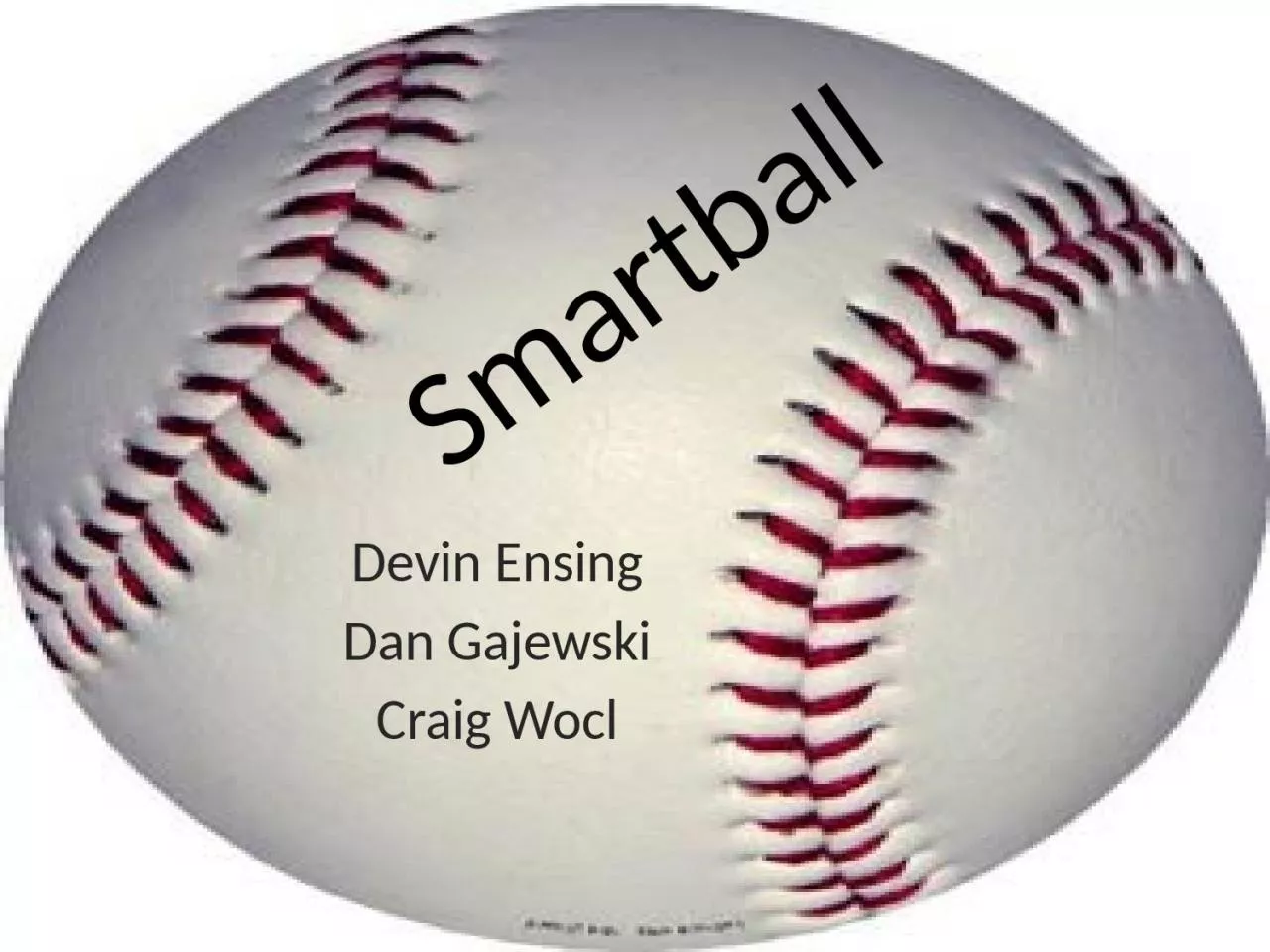

Gajewski Craig Wocl Article Purpose attempt to quantify the process that is used to build winning baseball teams Recognizing talent minor league performance Developing talent years in minor leagues ID: 933132
Download Presentation The PPT/PDF document "Smartball Devin Ensing Dan" is the property of its rightful owner. Permission is granted to download and print the materials on this web site for personal, non-commercial use only, and to display it on your personal computer provided you do not modify the materials and that you retain all copyright notices contained in the materials. By downloading content from our website, you accept the terms of this agreement.
Slide1
Smartball
Devin
Ensing
Dan
Gajewski
Craig
Wocl
Slide2Article
Purpose: attempt to quantify the process that is used to build winning baseball teams
Recognizing talent: minor league performance
Developing talent: years in minor leagues
Integrating talent: years with minor league team
Compensating talent: equitable payroll distribution
Slide3ArticleThe authors compared teams from 2000-2004
We are comparing teams from 2005-2008
Couldn’t replicate everything
e.g. the
Gini
coefficient = equal payroll distributionLooking mostly at payrolls and wins
Slide42009 MLB Payrolls
Highest Payroll
New York Yankees
$ 201,449,189
Lowest Payroll
Florida Marlins$ 36,834,000
The Marlins 6-year “business cycle”
Average Payroll: $88,513,173.13
Payrolls from 2008-09 actually decreased 1.7% - first time that has happened in the last few years
Slide5Average Annual Payroll 05-08
Slide6Total Wins 2005-2008
Slide72005
Test and CI for Two Proportions 2005 Top 10 vs. Rest of MLB
Sample
X N
Sample
pTop 10 869 1620 0.536420Rest 1561 3240 0.481790
Difference = p (Top 10) - p (Rest)
Estimate for difference: 0.0546296
95% lower bound for difference: 0.0296538Test for difference = 0 (
vs > 0): Z = 3.60 P-Value = 0.000Fisher's exact test: P-Value = 0.000
Test and CI for Two Proportions 2005 Bottom 10 vs. MLB
Sample
X N
Sample
p
Bottom 10 842 1620 0.519753
Rest 1588 3240 0.490123
Difference = p (Bottom 10) - p (Rest)
Estimate for difference: 0.0296296
95% lower bound for difference: 0.00461863
Test for difference = 0 (
vs
> 0): Z = 1.95
P-Value = 0.026
Fisher's exact test: P-Value = 0.028
Slide82006
Test and CI for Two Proportions 2006 Top 10 vs. MLB
Sample
X N
Sample
pTop 10 850 1619 0.525015Rest 1579 3239 0.487496
Difference = p (Top 10) - p (Rest)
Estimate for difference: 0.0375193
95% lower bound for difference: 0.0125107
Test for difference = 0 (vs > 0): Z = 2.47 P-Value = 0.007Fisher's exact test: P-Value = 0.007
Test and CI for Two Proportions 2006 Bottom 10 vs. MLB
Sample
X N
Sample
p
Bottom10 817 1620 0.504321
Rest 1613 3238 0.498147
Difference = p (Bottom 10) - p (Rest)
Estimate for difference: 0.00617398
95% lower bound for difference: -0.0188536
Test for difference = 0 (
vs
> 0): Z = 0.41
P-Value = 0.342
Fisher's exact test: P-Value = 0.354
Slide92007
Test and CI for Two Proportions 2007 Top 10 vs. MLB
Sample
X N
Sample
pTop 10 856 1618 0.529048Rest 1572 3238 0.485485
Difference = p (Top 10) - p (Rest)
Estimate for difference: 0.0435633
95% lower bound for difference: 0.0185565Test for difference = 0 (
vs > 0): Z = 2.87 P-Value = 0.002Fisher's exact test: P-Value = 0.002
Test and CI for Two Proportions 2007 Bottom 10 vs. MLB
Sample
X N
Sample
p
Bottom10 859 1618 0.530902
Rest 1556 3238 0.480544
Difference = p (Bottom 10) - p (Rest)
Estimate for difference: 0.0503588
95% lower bound for difference: 0.0253585
Test for difference = 0 (
vs
> 0): Z = 3.31
P-Value = 0.000
Fisher's exact test: P-Value = 0.001
Slide102008
Test and CI for Two Proportions 2008 Top 10 vs. MLB
Sample
X N
Sample
pTop 10 850 1619 0.525015Rest 1578 3237 0.487488
Difference = p (Top 10) - p (Rest)
Estimate for difference: 0.0375270
95% lower bound for difference: 0.0125159Test for difference = 0 (
vs > 0): Z = 2.47 P-Value = 0.007Fisher's exact test: P-Value = 0.007
Test and CI for Two Proportions Bottom 10 vs. MLB
Sample
X N
Sample
p
Bottom10 848 1619 0.523780
Rest 1580 3237 0.488106
Difference = p (Bottom 10) - p (Rest)
Estimate for difference: 0.0356738
95% lower bound for difference: 0.0106604
Test for difference = 0 (
vs
> 0): Z = 2.35
P-Value = 0.009
Fisher's exact test: P-Value = 0.010
Slide11$ per Win
Min
Q1
Med
Q3
Max
259,661
884,676
1,048,944
1,372,285
2,349,231 (NY Yankee)
365,508
650,303
1,021,994
1,225,009
2,017,437 (NY Yankees)
192,288
750,615
879,474
1,131,814
2,006,836 (NY Yankees)
442,971
651,402
828,657
1,089,529
2,192,703 (NY Yankees)
Variable
N
N*
Mean
SE Mean
St Dev
08 $/Win
30
0
1,107,290
79,473
435,289
07 $/Win
30
0
1,009,634
66,821
365,995
06 $/Win
30
0
946,620
60,629
332,081
05 $/Win
30
0
890,654
63,985
350,460
Slide12Slide13Slide14Slide15Class ActivityOpen P:\temp\0 Smartball
and Payrolls.MPJ
Slide16Conclusion
For the most part, teams that spend more money win more games.
Always a positive slope to the regression line within the scatter plots
The New York Yankees have had the highest payroll since 2005, and have had at least 89 wins each year.
Some small market team like the Rays (97 wins, AL Champions) in 2008 and the Indians (93 wins) in 2005 have had success while spending less money.
It all depends on how smart the team’s
management is with the money that they
are given.
Slide17Limitations and Further Research
Explore the
Gini
coefficient in depth more contemporary data
Look to see if the $/Win decreases this season with the drop in overall payrolls across baseball
Examine more closely teams that spend through free agency or teams that spend on “homegrown” talent (Twins?)
Slide18Referenceshttp://journals.ohiolink.edu/ejc/pdf.cgi/Sherony_Keith.pdf?issn=15341844&issue=v16i0001&article=21_saltrtmfbt
http://content.usatoday.com/sports/baseball/salaries/totalpayroll.aspx?year=2009
MLB.com